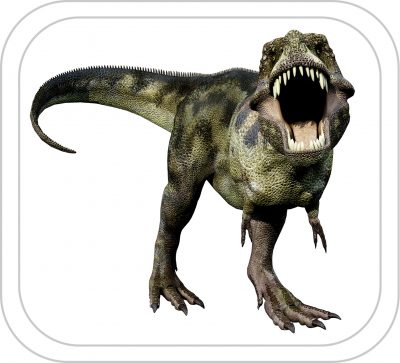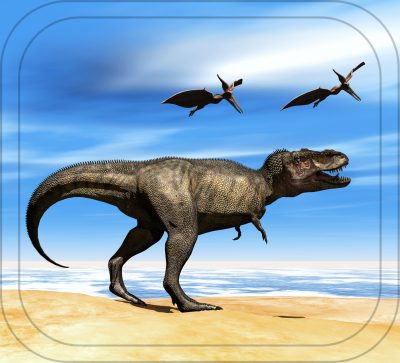Tyrannosaurus rex
Name: Tyrannosaurus Rex
Pronounced: tie-RAN-oh-sore-us
Meaning: ‘Tyrant lizard’
Period: Late Cretaceous (67 – 65 million years ago)
Group: Theropods (beast feet)
Size: It was 12m long and 5.6m tall. It weighed 7000kg.
Diet: Carnivore
Characteristics: The Tyrannosaurus Rex walked on two strong legs but its arms were only 1 m long with two-fingered hands. Its stiff, pointed tail was used as a counterbalance for its enormous head when making fast turns. Its skull was over 1.5m long and the jaw contained sixty sharp, pointy teeth, the largest being approximately 20cm long. Palaeontologists know the Tyrannosaurus could crush bones with their teeth, because they have found fossilised Tyrannosaurus dung, which contained the bones of its prey. Also there are distinctive bite marks on the fossils of the Triceratops, which match the teeth formation of the Tyrannosaurus. Plaster casts of the skull have shown the space for the part of the brain responsible for smell was quite big, indicating it had good sense of smell to hunt its prey. Its eyes were on the front of its face and the brain casts showed large visual lobes, so palaeontologists believe it had excellent depth perception for hunting. We know close relatives of the Tyrannosaurus sometimes lived together because fossils of groups have been found in the same place. However, we don’t know for sure if they hunted alone, or in packs. The largest complete skeleton is located at the Field Museum of National History, in Chicago and is nicknamed ‘Sue’.
Named by: Henry Fairfield Osborn in 1905
Discovery: Teeth from what is now documented as a Tyrannosaurus were found in 1874 by Arthur Lakes near Golden, Colorado. The first Tyrannosaurus skeleton was first found by Barnum Brown in 1902, in Hell Creek, Montana, North America. Isolated fossilised footprints have also been assigned to the Tyrannosaurus. The first was discovered at Philmont Scout Ranch, New Mexico, in 1983 by American geologist Charles Pillmore. The second was found in the Hell Creek Formation of Montana in 2007, by British palaeontologist Phil Manning.




